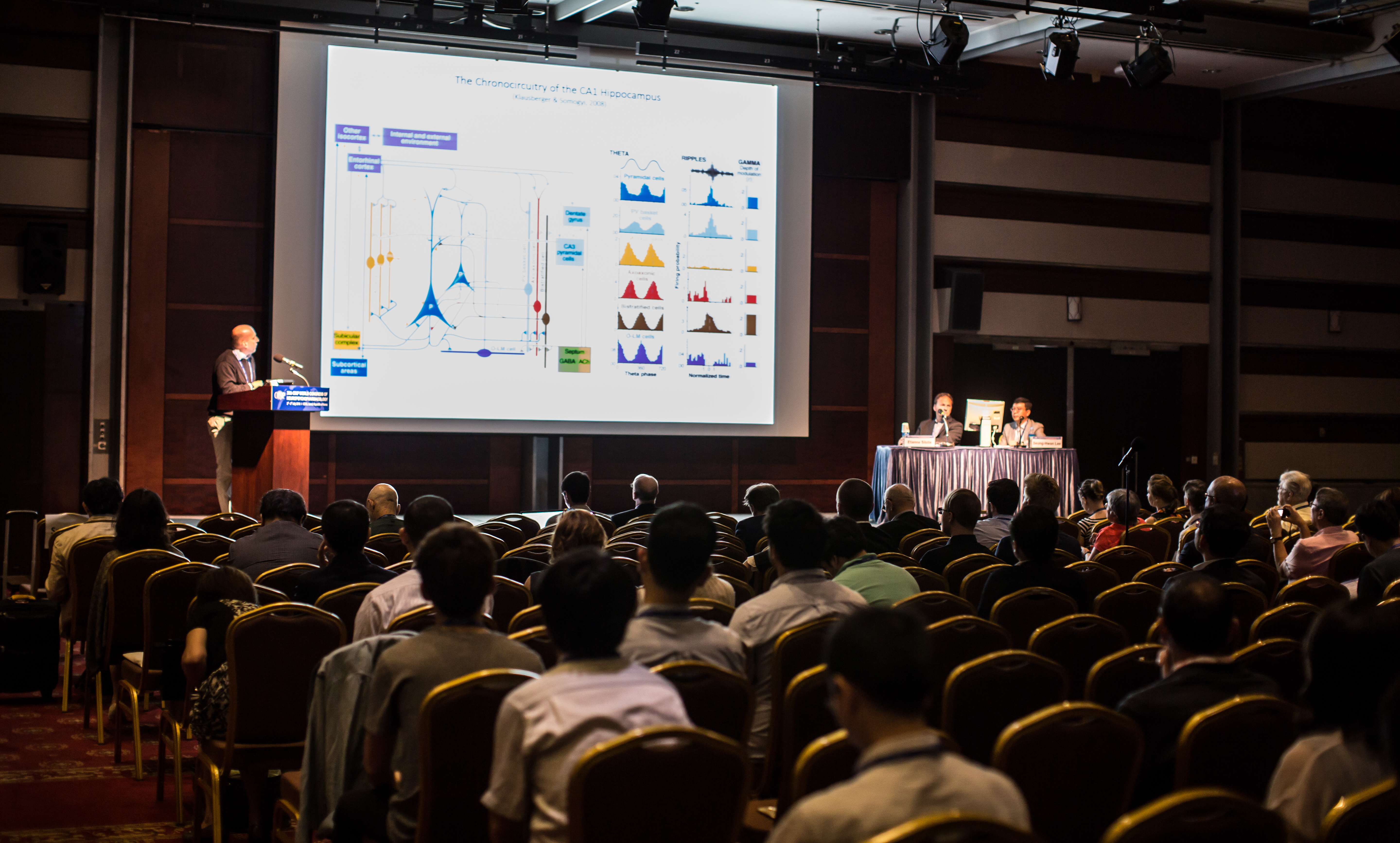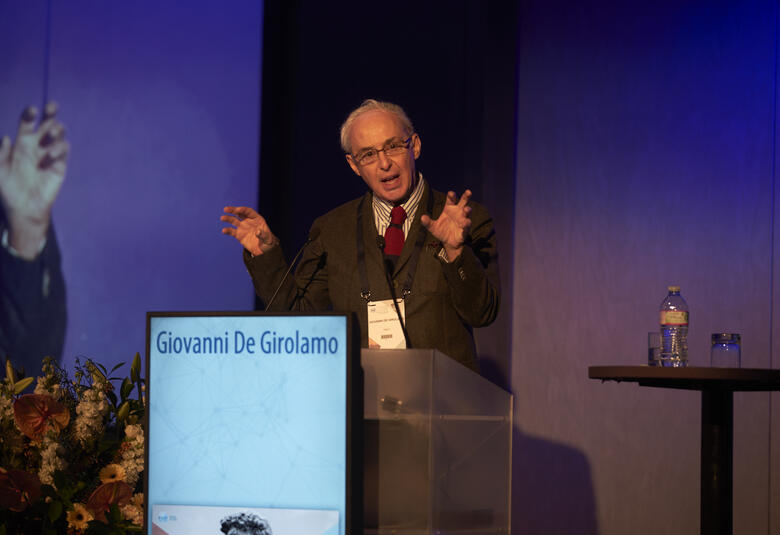
Depression circuitry – an integrated approach
Professors Anthony Grace, USA, and Heon-Jeong Lee, Republic of Korea, co-chaired a fascinating first symposium on Sunday morning at CINP. Its aim was to give an integrated view of the latest thinking about the circuitry of depression and how imaging studies can help facilitate the development of more effective therapies.
Serotonin in depression – a lesson from SAD perhaps?
In the first of four talks, Professor Gitte Moos Knudsen, Denmark, gave an overview of the serotonin system and its contribution to controlling intrinsic brain activity in humans. Of particular interest were the large number of Positron Emission Tomography (PET) studies that have sought to identify the influence of the various regions thought to be involved in depression and mood disorder.
A total of 34 studies investigating the effect of mood disorder on 5HT receptors are compiled in a recent review. Although in general it appears that post-synaptic 5HT1A receptor binding potential is decreased in mood disorders, this finding was not consistent across all the studies included. This was also the case for 5HT2A and 5HT1B, both pre-and post-synaptic. Likely reasons for such inconsistencies include use of different radioligands, poor statistical power, disease heterogeneity, medication associated differences between studies and cross-sectional data acquisition. This inconsistency of results between studies suggests the situation surrounding 5HT receptor binding in MDD is complex and much still remains to be discovered.
However, a longitudinal study that exemplifies nicely the influence of serotonin transporter (5HTT) binding on outcome considered seasonal affective disorder (SAD). Patients in Copenhagen were assessed both during the summer (when they were not affected) and again in winter. Patients with SAD appear unable to down-regulate their 5HTT binding globally. This was not the case when they were unaffected by SAD. The degree of lack of availability of 5HTT appears related to symptom severity. Thus, it may be possible to predict those most likely to be affected by SAD and possibly effect a specific therapy.
MRI – discovering hotwired networks
Several promising approaches in high-field functional magnetic resonance imaging (fMRI) in depression were presented by Professor Quiyong Gong, China. He explained how the circuitry associated with depression correlates with refractoriness in treatment-resistant depression and with suicidality. Such associations could facilitate diagnosis and likely response to antidepressant therapy in the future.
For example, diffusion tensor imaging studies, a type of MRI that facilitates examination and characterization of neural connectivity in the brain, have identified abnormal alterations in the frontal-striatal circuits that pass through the anterior limb of the internal capsule in suicidal patients with MDD. Additionally, such studies have identified functional connectivity differences related to responsiveness to treatment. Thus, patients with non-refractory and refractory MDD exhibit changes in their limbic-striatal-pallidal- thalamic and thalamo-cortical circuits, respectively.
Professor Gong also described brain connectosome studies in patients with MDD. Changes to core networks identified using resting fMRI are seen in this heterogeneous condition. It has been postulated that the default mode network, the salience network and the central executive network are linked together through the dorsal nexus and could explain how MDD symptoms arise in discrete clusters, such as rumination or excessive self-focus.
Thus, high-field MRI allows investigation of brain circuitry and connectosomal abnormalities, not only giving us a tantalizing glimpse of the underlying psychopathology of MDD but also a means of facilitating its early detection, assessment of prognosis and intervention.
Dopamine - change of focus in depression
Professor Anthony Grace presented work in animal models of depression – but with a dopaminergic perspective.
Considerable evidence has now accrued supporting a role for dopamine in depression. For example, exposing laboratory animals to chronic mild stress (CMS) over a 4-6 week period generated behaviour, assessed using the forced swim test or learned helplessness, that mimics depression.
What impact do such stressors have on the dopaminergic system in these animals? Examination of activity in dopaminergic neurons through probes placed in the ventral tegmental area (VTA) showed a reduction in the number of neurons available to respond to reward stimuli when these were offered. Such a finding suggests that this response could be the murine equivalent to human anhedonia, a feature usually associated with depression.
What happens in terms of dopaminergic activity in the murine equivalent of Brodmann Area 25 - an area associated with MDD? Activation of the infralimbic prefrontal cortex (ILPFC) in normal rats suppresses VTA DA neuron activity, primarily in the medial VTA while activation of the lateral habenula (LHb) inhibits such activity in the central and lateral VTA. In stressed rats, however, only ILPFC inactivation restores VTA DA neuron activity – inactivation of the LHb had no restorative effect.
The effects of ketamine in rats exposed to learned helplessness has also been examined. In these animals, decreased DA neuron activity and long-term depression in the hippocampus-accumbens are noted. Thus, lack of hippocampal drive appears not to compensate for any ILPFC down-regulation. Just one dose of ketamine, however, restores hippocampal-accumbens drive, normalizes dopamine neuron firing, and reverses behavioural despair in the forced swim test.
Taken together, it appears that the ILPFC and LHb regulate different subpopulations of DA neurons within the mesolimbic system. Such differential regulation can help explain the unique restorative capacity of ILPFC inactivation in reversing the abnormal DA system hypoactivity observed in stressed rats.
DREADD and optogenetics – the way ahead in depression
Professor Alan Fraser, USA, is interested in ketamine. More specifically, he is interested in describing the circuits underlying the sustained effects of a single ketamine injection and understanding how ketamine impacts the ventral-hippocampal to medial PFC pathway.
Three pieces of evidence support the idea that the VHipp-mPFC pathway is needed for ketamine to elicit its anti-depressant effect:
- Bilateral lidocaine inactivation of the ventral hippocampus (vHipp) in animal models at the time of ketamine administration completely blocks the sustained anti-depressant response to ketamine at one week post-injection. (This anti-depressant effect was assessed using the forced swim test.)
- Optogenetic inactivation of the VHipp-medial PFC pathway completely reversed the anti-depressant-like effects of ketamine at the time of testing.
- Gq activation of the VHipp-mPFC pathway but not the VHipp-NAC pathway produces an anti-depressant response.
Thus, the sustained anti-depressant-like effect of ketamine is mediated by activation of a circuit from the VHipp to the mPFC.
Is it possible to mimic ONLY ketamine’s anti-depressant effect?
Potential selective inhibition of the α5-GABAA receptors in the hippocampus or activation of 5-HT4 receptors present there produces a sustained anti-depressant-like effect. Ketamine’s reinforcing effects, as shown by its being self-administered in animal experiments, likely account for its abuse-related properties. By contrast L655 708, a selective negative allosteric modulator of the α5-GABAA receptor, is not self-administered by rats, showing that ketamine’s good and bad effects can be teased apart. This suggestion is reinforced when considering that, unlike the α5-GABAA receptor inverse agonists or RS67333, a 5-HT4 partial antagonist, ketamine disrupts the inhibition of the acoustic startle response. Thus, it should be possible to develop new antidepressants that exhibit the beneficial effects of ketamine without the negative ones.



